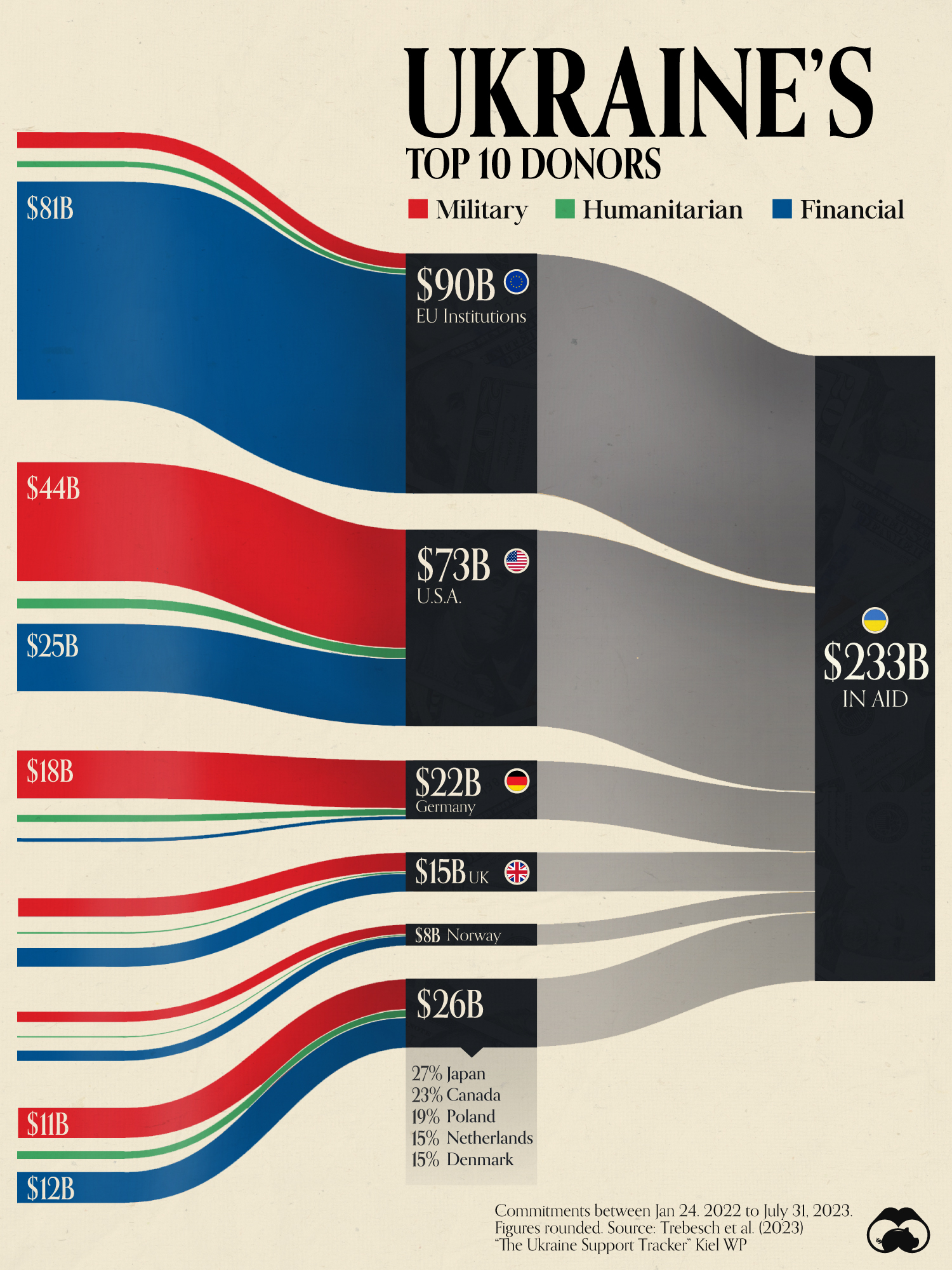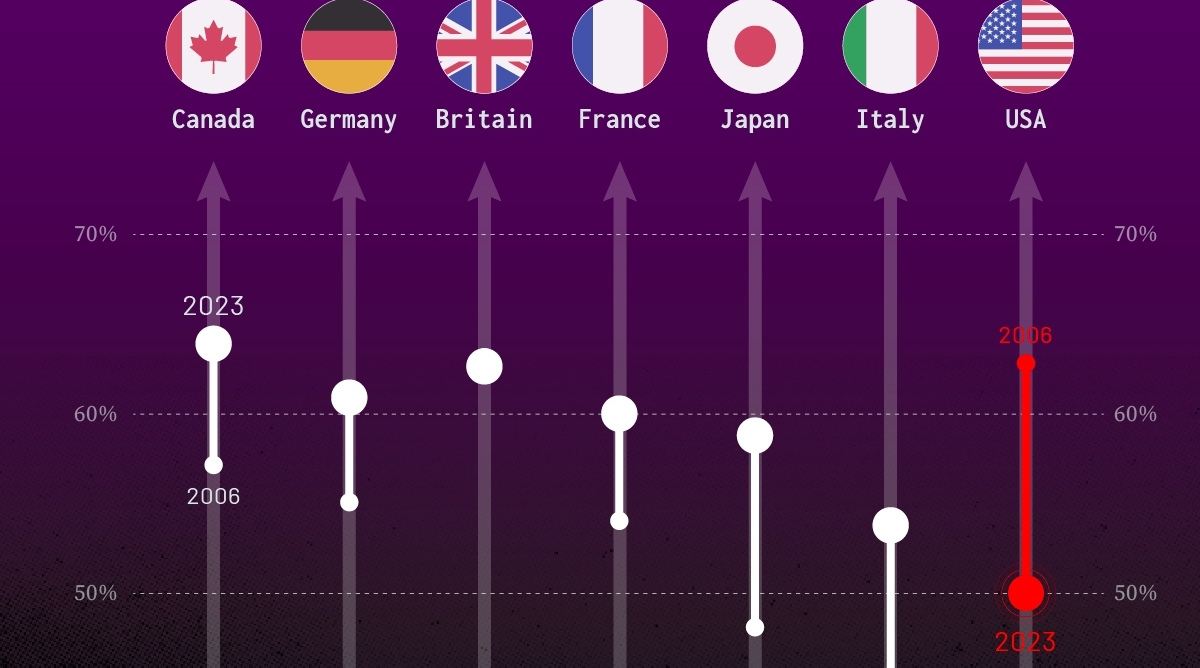Politics
Visualizing $233B in Ukraine Aid

The Top 10 Donors to Ukraine
Ukraine has received over $230 billion in aid since the Russian invasion in 2022.
EU institutions and the U.S. together account for almost 70% of the total aid.
This graphic uses data from the Ukraine Support Tracker to visualize the top 10 donors to Ukraine between Jan 24, 2022, and July 31, 2023.
European Union is the Biggest Donor
Military aid to Ukraine includes weapons, equipment, and items explicitly donated to the Ukrainian army.
The graphic also illustrates humanitarian aid to assist civilians and financial aid like grants, loans, and guarantees made to the Ukrainian government. It does not include private donations, support for refugees outside of Ukraine, or assistance from international organizations.
As of July 2023, the European Union institutions have been the biggest donor, sending over $90 billion through various mechanisms such as loans or grants, and military assistance through its European Peace Facility fund.
Unlike the United States, which has the largest share of aid in military support, the EU has focused on financial aid.
| Donor | Military (Billion USD) | Humanitarian | Financial | Total |
|---|---|---|---|---|
| 🇪🇺 EU Institutions | 5.9 | 2.2 | 81.4 | 89.5 |
| 🇺🇸 U.S. | 44.4 | 3.7 | 25.1 | 73.2 |
| 🇩🇪 Germany | 18.0 | 2.6 | 1.4 | 22.1 |
| 🇬🇧 UK | 7.0 | 0.6 | 7.0 | 14.6 |
| 🇳🇴 Norway | 3.9 | 0.2 | 3.8 | 7.9 |
| 🇯🇵 Japan | 0.0 | 1.0 | 5.8 | 6.8 |
| 🇨🇦 Canada | 1.8 | 0.4 | 3.6 | 5.8 |
| 🇵🇱 Poland | 3.2 | 0.4 | 0.9 | 4.5 |
| 🇳🇱 Netherlands | 2.6 | 0.6 | 1.1 | 4.3 |
| 🇩🇰 Denmark | 3.7 | 0.3 | 0.1 | 4.1 |
| Total | 90.5 | 12.2 | 130.1 | 232.9 |
EU aid includes $3.3 billion for lethal equipment and an additional $2.1 billion to supply Ukraine with one million rounds of ammunition.
The bloc is considering providing up to $53 billion in financial assistance to Ukraine (in loans and grants) for the 2023-2027 period, including using frozen Russian assets to support Ukraine’s reconstruction.
While not captured in this dataset, Denmark and the Netherlands announced in August 2023 that they would donate up to 61 F-16 fighter jets to Ukraine.
U.S. Support
After the European Union, the United States is the biggest donor, with over $70 billion.
The country has already disbursed 96% of the funds allocated to Ukraine since the start of the war, and this has sparked a political controversy.
While the Biden administration strongly defends a $106 billion Emergency National Security Supplemental Request to help Ukraine and Israel, Republican senators oppose the current budget, which contains an additional $60 billion in aid for Ukraine.
Politics
Charted: Trust in Government Institutions by G7 Countries
How much do you trust the government and its various institutions? We look at data for G7 countries for the time period of 2006-2023.

Trust in Government Institutions by G7 Countries
This was originally posted on our Voronoi app. Download the app for free on iOS or Android and discover incredible data-driven charts from a variety of trusted sources.
How much do you trust the government, and its various institutions?
It’s likely that your level of confidence probably depends on a wide range of factors, such as perceived competency, historical context, economic performance, accountability, social cohesion, and transparency.
And for these same reasons, trust levels in government institutions also change all the time, even in the world’s most developed countries: the G7.
Confidence in Government by G7 Countries (2006-2023)
This chart looks at the changes in trust in government institutions between the years 2006 and 2023, based on data from a multi-country Gallup poll.
Specifically, this dataset aggregates confidence in multiple national institutions, including the military, the judicial system, the national government, and the integrity of the electoral system.
| Country | Confidence (2006) | Confidence (2023) | Change (p.p.) |
|---|---|---|---|
| Canada | 57% | 64% | +7 |
| Britain | 63% | 63% | +0 |
| Germany | 55% | 61% | +6 |
| France | 54% | 60% | +6 |
| Japan | 48% | 59% | +11 |
| Italy | 41% | 54% | +13 |
| United States | 63% | 50% | -13 |
What’s interesting here is that in the G7, a group of the world’s most developed economies, there is only one country bucking the general trend: the United States.
Across most G7 countries, confidence in institutions has either improved or stayed the same between 2006 and 2023. The largest percentage point (p.p.) increases occur in Italy and Japan, which saw +13 p.p. and +11 p.p. increases in trust over the time period.
In the U.S., however, confidence in government institutions has fallen by 13 p.p. over the years. What happened?
Key Figures on U.S. Trust in Institutions
In 2006, the U.S. was tied with the UK as having the highest confidence in government institutions, at 63%.
But here’s where the scores stand in 2023, across various institutions:
| 🇺🇸 Institutions | Confidence (2023) |
|---|---|
| Military | 81% |
| Judiciary | 42% |
| National Government | 30% |
| Elections | 44% |
| Overall | 49% |
Based on this data, it’s clear that the U.S. lags behind in three key indicators: confidence in the national government, confidence in the justice system, and confidence in fair elections. It ranked in last place for each indicator in the G7.
One other data point that stands out: despite leading the world in military spending, the U.S. is only the third most confident in its military in the G7. It lags behind France (86%) and the United Kingdom (83%).
-

 Wealth6 days ago
Wealth6 days agoCharted: Which City Has the Most Billionaires in 2024?
-

 Mining2 weeks ago
Mining2 weeks agoGold vs. S&P 500: Which Has Grown More Over Five Years?
-

 Uranium2 weeks ago
Uranium2 weeks agoThe World’s Biggest Nuclear Energy Producers
-

 Education2 weeks ago
Education2 weeks agoHow Hard Is It to Get Into an Ivy League School?
-

 Debt2 weeks ago
Debt2 weeks agoHow Debt-to-GDP Ratios Have Changed Since 2000
-

 Sports2 weeks ago
Sports2 weeks agoThe Highest Earning Athletes in Seven Professional Sports
-

 Science2 weeks ago
Science2 weeks agoVisualizing the Average Lifespans of Mammals
-

 Brands1 week ago
Brands1 week agoHow Tech Logos Have Evolved Over Time












